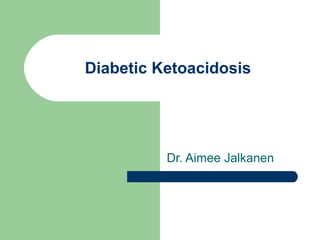
Diabetic Ketoacidosis Presentation
- 1. Diabetic Ketoacidosis Dr. Aimee Jalkanen
- 2. What is Diabetic Ketoacidosis (DKA)? Life-threatening metabolic condition Result of insulin deficiency and resistance Excessive production of ketoacids by the liver Leads to metabolic acidosis, hyperosmolality, electrolyte imbalances, systemic illness http://petdiabetes.wikia.com/wiki/Ketoacidosis
- 3. Etiology and Pathophysiology Shift in hepatic metabolism from fat synthesis to fat oxidation and ketogenesis produces ketone bodies (acetoacetic acid, β- hydroxybutyric acid, acetone) Insulin deficiency and resistance leads to increased production of ketones Lipolysis increases, thus more FFAs are available for the liver to produce ketones http://petdiabetes.wikia.com/wiki/Ketoacidosis
- 4. Etiology and Pathophysiology Accumulation of ketones overwhelms the body’s buffering system leading to metabolic acidosis Renal tubules are unable to have complete resorption leading to ketonuria Osmotic diuresis ensues leading to increased loss of Na+, K+ in urine Loss of electrolytes and fluid through urine and vomiting leads to azotemia, cellular dehydration
- 5. Common Signalment Older dogs (7-9) and cats (9-11) Female dogs 2x > males Male cats > females Multiple dog breeds commonly affected include: Schnauzer, Poodle, Bichon Frise, Keeshond Cats: no breed disposition thepawblog.com blog.halopets.com www.ehow.com
- 6. Pertinent History May or may not be a previously diagnosed diabetic Have shown signs of diabetes including PU/PD, weight loss despite increased appetite Recent history includes vomiting, weakness, anorexia
- 7. Physical Exam Findings Dehydration-often moderate to severe Weakness Respiratory pattern changes: tachypnea or Kussmaul’s respiration (slow, deep breathing) Abdominal pain (associated with pancreatitis) Strong acetone odor to breath (sweet smell) Cataracts (more common in dogs) Diabetic neuropathy (dropped hocks, more common in cats)
- 8. Diagnostics Complete blood count Biochemical profile Electrolyte panel Urinalysis and culture Radiographs, ultrasound, and further diagnostics may be needed
- 9. Results CBC – Variable, may show high white blood cells Profile – High blood glucose, low sodium, low potassium – High cholesterol – Liver enzyme elevation – Azotemia Urinalysis – Positive ketones – Glucosuria – Pyuria and bacteria common if concurrent UTI cPL positive if concurrent pancreatitis
- 10. Treatment-Fluid Therapy Crystalloid, type based on electrolytes Supplement with potassium – Usually 30-40 mEq/L Supplement phosphorus if <1.5mg/dL – Necessary to avoid hemolytic anemia Add 2.5-5% dextrose to fluids once BG approaches 250 mg/dL
- 11. Treatment-Insulin Begin after starting fluid therapy Intermittent IM technique: – 0.2 U/kg IM initially – Then, 0.1 U/kg IM hourly Insulin CRI – 0.05 U/kg/h (cat) 0.1 U/kg/h (dog) in 0.9% NaCl Adjustments made based on BG – Switch to every 0.1 U/kg 6 to 8 h SQ once BG ~ 250 mg/dL Goal is to slowly decrease BG until between 100-300 mg/dL
- 12. Treatment-Other Bicarbonate supplementation – Use with caution – Supplement if bicarb is < 12mEq/L – HCO3 - = body weight (kg) x 0.4 x (12 - patient’s HCO3 - ) x 0.5 – Add to fluids and given over 6 h Anti-emetics if needed to control vomiting Nutrition: Very important to encourage patient’s to eat to avoid hypoglycemia Antibiotics: Many patients have concurrent UTIs
- 13. Monitoring Frequent blood glucoses – Initially every 1 to 2 hours – May begin to decrease when BGs stabilize Hydration status – Monitor inputs (fluids) and outputs (urine, vomit, diarrhea) – Make adjustments as needed Electrolyte concentrations – Adjust fluids and additives as necessary Patient’s weight, temperature, blood pressure
- 14. Potential complications Goal is to correct blood glucose, acidosis, and electrolyte abnormalities SLOWLY (24- 48 hours) Hypokalemia, hypoglycemia, hypernatremia, hemolytic anemia commonly occur Neurologic signs related to cerebral edema
- 15. Long-term Care and Follow-up Treat concurrent diseases – Urinary tract infections – Diarrhea – Pancreatitis – Cushing’s disease Establish good control over blood glucose levels – Regular check-ups – Blood glucose curves to help establish insulin dose free-glucose-meter.com
- 16. Long-term Care and Follow-up Dietary changes – Controlled weight loss – High fiber, low calorie, low-fat diets – Hill’s w/d, r/d, or m/d, Purina’s OM or DM, other senior or weight loss diets – Avoid giving treats or snacks high in fat and sugar Encourage regular exercise findavet.us
- 17. At home care and monitoring Owners of diabetics need to be aware of DKA and its life-threatening nature Have owners contact a veterinarian if: – Patient is vomiting or having diarrhea – Stops eating – Becomes lethargic – Urine and/or breath smells “funny”
- 18. DKA on ER May be a stat triage-many of these patients are very ill Brief history from owner-if known diabetic, ask about insulin, when and how much last given and has patient been eating Ask permission for IV catheter, diagnostics (about $150 to $200 to start)
- 19. Once in treatment room Obtain blood for CBC/profile and a urine sample Run an I-stat 8 – Glucose, pH, electrolytes Check urine dipstick – Look for ketonuria (if negative, does NOT rule out DKA) Place IV catheter Prepare fluids http://www.clickmdlab.com http://www.bidbuy.co.kr
- 20. Sources Côté, Etienne (ed): Clinical Veterinary Advisor. St. Louis, Mosby, Inc. 2007. Hill’s Key to Clinical Nutrition 2007-2008.
- 21. Thanks for your attention!